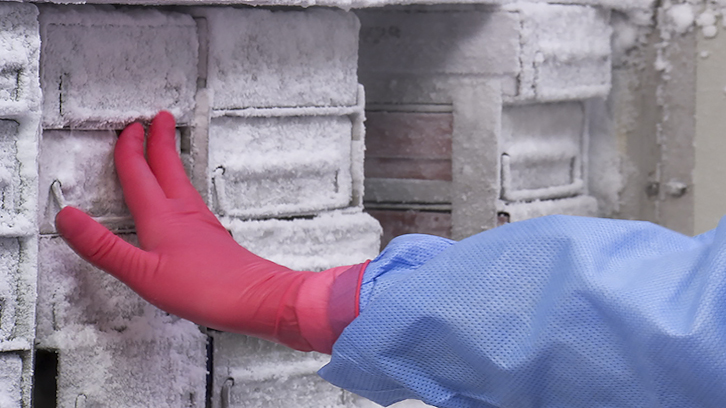Induction of a cold-inducible protein in cumulus cells: a new step for improving oocyte vitrification?

Vitrification preserves the functions of cells at -196ºC, but the tolerance of these extreme temperatures is still insufficient for the oocytes. To increase the vitrification tolerance, the group ERPAW/GRI-BCN of the UAB has studied if the pre-treatment with cold (cellular stress) could induce and increase the oocyte resistance to the process. Besides, the group has observed that the low temperatures induce a cold-inducible protein (CIRBP) in the layer of cumulus cells that surround the oocyte, which could help to increase the oocyte tolerance towards the vitrification process.
Keeping viable cells at temperatures below 0 ºC during indefinite time is a reality. There are two major cryopreservation techniques: freezing and vitrification. The big difference between them is the lack of ice crystal formation in vitrification, avoiding breaking up the cells. The word “vitrification” comes from Latin vitreum, glass, a non-crystalline amorphous solid. The vitrification is more convenient for cells with a marked sensibility to cooling injuries, like oocytes (also known as ovum or eggs), essential to reproduction.
What’s the point of cryopreservation?
The oocyte vitrification process preserves the functionality of the oocytes despite being kept at -196 ºC (temperature of liquid nitrogen) over indefinite time. This technology allows the conservation of animal genetic resources and preservation of fertility in women. However, there are still some difficulties in applying vitrification to these cells. For that reason, different strategies have been used to improve cryotolerance in mammalian oocytes. One of them is what is known as “stress for stress tolerance”, that is, mild stress may help resist greater stress. We could say that it is a workout to be able to face a great effort.
Low temperatures induce the expression of the so-called cold-inducible proteins. These proteins play fundamental roles in diverse cellular processes. One of the major studied cold-inducible proteins is the cold-inducible RNA-binding protein, also known as CIRBP. Since its discovery in the late 1990s, CIRBP has been related to many cellular stress responses, such as cell survival.
Is it possible that exposing oocytes to low temperatures, before vitrification, may induce cryotolerance? In other words, can we induce cold tolerance trough cold stress?
This is our working hypothesis. Our study, conducted with bovine ovary cells, has shown that CIRBP, a cold stress protein, can be induced from the layer of cells that surround the oocyte, the cumulus cells. These cells are in close contact with the oocyte and are fundamental to effective oocyte maturation and fertilization, essential processes to reproduction. Besides, previous research reported that the cumulus cells are indispensable to resist the vitrification process. The increase of CIRBP expression in cumulus cells could play important roles in oocyte cryoprotection, thus improving their response to vitrification. However, further studies are needed to demonstrate it.
*Thesis supervisors: Dr. López Béjar & Dr. Álvarez Rodríguez
ERPAW Research Group (Endocrinology, Reproductive Physiology and Animal Welfare Research Group)
GRI-BCN (Research Group on Infertility, Barcelona)
Departament de Sanitat i d'Anatomia Animals
Àrea d'Anatomia i d'Anatomia Patològica Comparades
Facultat de Veterinària
Universitat Autònoma de Barcelona (UAB)
References
Jaume Gardela, Mateo Ruiz-Conca, Manuel Álvarez-Rodríguez , Teresa Mogas, Manel López-Béjar. Induction of CIRBP expression by cold shock on bovine cumulus-oocyte complexes. Reprod Domest Anim. 2019 Oct;54 Suppl 4:82-85. doi: 10.1111/rda.13518.


